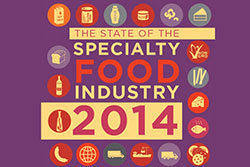Sales of specialty food and beverages in the United States reached $88.3 billion in 2013, a record high for the fourth year in a row and a jump of 18.4% since 2011. Cheese dominated the retail market, accounting for almost $4 billion in sales. Ranking second was frozen and refrigerated meat, poultry and seafood, which generated $2.26 billion in receipts. Placing third was chips, pretzels and snacks, at $2.189 billion.
The fastest growing categories are nut and seed butters (+51.6% to $231 million), eggs (+35.9% to $228 million) and frozen desserts (+28.2% to $1.343 billion), according to research detailed in The State of the Specialty Food Industry 2014 report just published by the New York City-based Specialty Food Association
 Specialty foods are broadly defined for the report as products that have limited distribution and a reputation for high quality. The report does not include private label product sales, PLU items, or sales through Trader Joe’s, Walmart, or Whole Foods stores.
Specialty foods are broadly defined for the report as products that have limited distribution and a reputation for high quality. The report does not include private label product sales, PLU items, or sales through Trader Joe’s, Walmart, or Whole Foods stores.
The retail segment overwhelmingly dominates the specialty food market, accounting for 79.5% of all sales at $70.1 billion. Furthermore, specialty food retail sales represent 10.4% of the entire retail market.
Foodservice sales of $18.1 billion claim 20.5% of the total specialty food market.
Other frozen product segment results detailed in the report were quantified as follows:
- Lunch and Dinner Entrees: +5.2% to $1.179 billion in sales value, but down 4.2% in unit movement
- Fruits and Vegetables: +24.9% in value to $357 million; -0.7% in units moved
- Appetizers and Snacks: +7.6% to $265 million in sales; +3.9% in units
- Breakfast Foods: +13% to $123 million in value; +5.8% in units
- Juices and other Beverages: +3.4% to $6 million in sales; but -22% in units moved
In comparison, 2013 sales in the total retail market (including sales at specialty food stores) for the above mentioned categories checked out as follows:
- Frozen and Refrigerated Meats, Poultry and Seafood: $32.149 billion (+5.6% since 2011; 8.2% of total market)
- Frozen Desserts: $13.937 billion (+3.2%; 3.6% share of market)
- Lunch and Dinner Entrees: $14.901 billion (-3% in sales; 3.8% market share)
- Fruits and Vegetables: $5.625 billion (+6.1% sales volume; 1.4% share of market)
- Appetizers and Snacks: $2.002 billion (+2.5% sales; 0.5% market share)
- Breakfast Foods: $3.035 billion (+11.9% sales; 0.8% share of market)
- Juices and other Beverages: $394 million (-14.7% sales; 0.1% share)
“US consumers are more sophisticated and discerning about their food choices than ever before,” said Ron Tanner, a vice president with the Specialty Food Association. “Retailers and restaurants of all kinds are responding by offering more specialty foods crafted by makers of artisanal cheeses, innovative vinegars and health-oriented snacks.”
The outlook for retail is robust, with sales at specialty food stores and natural markets skyrocketing by 42.4% and 33.8%, respectively, between 2011 and 2013. Mainstream supermarket sales growth was more sluggish, at 6.9%.
Foodservice sales at cafés, fast-casual chains, restaurants and venues from casinos to cruise ships represent one-fifth of the specialty food market. Sales in this sector remained steady at $18.1 billion in 2013, but manufacturers report it is their slowest-growing sales channel. Importers, however, report growth.
Distributors of specialty food say non-GMO offerings have the highest potential for growth of all product claims during the next three years. Seventy percent of retailers surveyed cite “local” as the claim that interests consumers most today.
These finding are included in The State of the Specialty Food Industry 2014, an annual report from the Specialty Food Association prepared in conjunction with research firms Mintel International and SPINS. The report tracks US sales of specialty food through supermarkets, natural food stores and specialty food retailers and includes surveys of food manufacturers, importers, distributors, brokers and retailers.
More details, as well as a 16-page overview of the report, are available by visiting specialtyfood.com/stateindustry2014.





